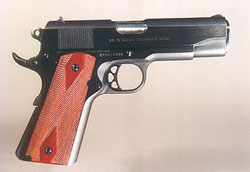
By Syd
I wasn’t really looking for it. I guess you could say that it found me. I was looking for a project gun, like a Sistema or a beater M1911A1 for a project gun. I stopped into Oakwood Guns in Louisville and scanned the display case. It just jumped out at me – a blued Colt Commander. I asked the man behind the counter to show me the gun. He said, “I’ll tell you something neat about the gun. It has a Series 80 serial number but it’s one of the early ones that didn’t have the damned firing pin block, like a Series 70 for a Series 80 price. And, it’s not a Commander; it’s a Combat Commander – all steel frame.” I have since been told that these guns are actually Series 70 guns which got the “80BS…” serial numbers because of record-keeping issues at Colt, and not because they are actually Series 80 guns. It has no Series 80 parts or characteristics. The price tag on the gun was $549. He handed it to me. It had the bottomless bluing of Colt’s golden age. No scratches, no holster wear, and the only flaw I could find with it was that someone had removed the original walnut grips and replaced them with a set of Pachmayr wrap-arounds. Well, it was love. A swipe of the credit card and the infernal NICs check, and it was mine.
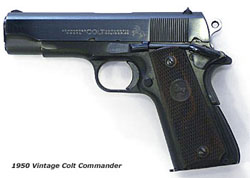
There is something a bit magical about the guns built by Colt before they had their troubles in the mid-80’s and early 90’s. There’s a certain solidness and fineness of fit and finish, the legendary mystique of the rampant colt, and other intangibles that most of the newer guns just don’t have, be they Colt, Kimber or whatever. In my sojourn with the 1911, I have come to the conclusion that the Commander format is the ideal setup for me. The 5″ guns are a little slow to get on target for me. The Kimber Compact is a great CCW gun (if a bit heavy) because of the short Officers’ size grip, but at matches, I have had times that I missed the extra round and have suffered lousy times because of a reload that others didn’t have to make. The full-length grip of the Commander is also a bit steadier and more comfortable in the hand. I had decided that my next “nice” gun would be a Kimber Pro-Carry HD, their all steel Commander-format gun, but they have added the bloody firing pin block and I’m not at all taken with their design. (You have to remove the rear sight to get the plunger out. I don’t like it. It is essentially a resurrection of the Swartz safety developed for Colt before the Second World War.) With the big name manufactures going to lawyer-friendly firing pin blocks and integral safety locks, I’m seeing the 20-year old pure 1911 in a new light.
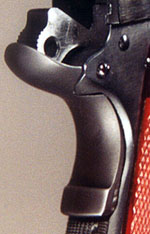
Brief History of the Commander
Shortly after the Second World War, the United States Government began sponsoring a series of tests to find a new pistol to replace the Colt M1911A1. One of the key requirements dictated at the time was that the pistol was not to exceed 7.0 inches in length or 25 ounces in weight. These tests were conducted at Aberdeen Proving Grounds as well as at Fort Benning, Georgia. The pistols submitted at this time were the S&W M39, the Colt Commander, a modified Inglis Hi Power, a FN Hi Power and the T3 trial pistol, all chambered in 9mm Parabellum. Proposed at the end of 1949, the Commander was intended to fill a military need for a lighter handgun intended for officers. None of these pistols were selected for the Armed Forces during this round of tests, but Colt wisely decided to go forward with commercial production of the Commander and it proved itself to be a popular and successful design. It was available in several chamberings including the 9mm Parabellum, .45 ACP and the .38 Super. Prior to 1970, Commander frames were made in a light aluminum alloy, called “Coltalloy®”. It was the first time that any name-brand auto pistol manufacturer had used an aluminum frame in a regular-production big-bore gun. Another first for the Commander was that it was the first Colt 1911 designed specifically with the 9mm Parabellum cartridge in mind. In 1970, an all-steel version was introduced under the name of “Combat Commander”. From 1970 on, the Commander was referred to as the “Lightweight Commander.” Colt has continued to build Commander-style pistols through its successive design permutations. The Gold Cup, MKIV Series 80, M1991A1, and XSE series have all included Commander and Lightweight Commander models.
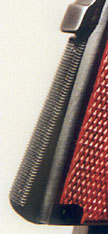
Modifications
Box stock, the gun seemed pretty much perfect except for one glaring problem: after a hundred and fifty rounds of quick draw and speed shooting exercises, I had a bloody hole in the web of my hand. The original Combat Commander has the stubby grip safety of the old M1911. It wasn’t hammer bite that was causing the injury but rather the left bottom edge of the grip safety tang was digging into my hand during the recoil cycle.
I was told that Wilson Combat made a “drop-in” beavertail for the Commander that fit pretty well, and not really wanting to cut the frame of the pistol, I ordered the Wilson drop-in and flat mainspring housing. When the order arrived, I found that I had been sent not a flat mainspring housing, but the Wilson V-grip mainspring housing. The V-grip is interesting. It’s flat but it flares at about a 5-degree angle from the grip. The theory behind this geometry is that it tends to force your hand to a higher grip. This does seem to be the case. It also seems to counteract my tendency to let the front sight drop. Although I hadn’t ordered the V-grip, I figured it was probably kismet that I received it and the concept was interesting. Consequently, I installed the drop-in beavertail and the V-grip.
The “drop-in” beavertail was pretty much “drop-in” insofar as it fits into the gun without cutting the frame. There is a very small gap between the beavertail and frame but it’s not large enough to call attention to itself and it looks nice. It was not “drop-in” to the extent that we had to trim the trigger stop to get the trigger to work. You would think that a “drop-in” beavertail for a Colt Commander would fit in a genuine Colt Commander without a lot of trimming, but I guess not.
With the V-grip and the beavertail installed, I was definitely beginning to like the way the gun was looking. However, with the new parts installed, a new problem emerged. The trigger was gritty and noticeably heavier than it had been with the stock mainspring housing. At first, I thought there might be a difference in the well in the V-grip housing causing greater mainspring tension, but a friend on the 1911 Tech Talk list suggested that it was not a mainspring but a sear spring issue. He suggested that the V-grip was slightly deeper inside the grip and therefore causing more pressure on the sear spring.
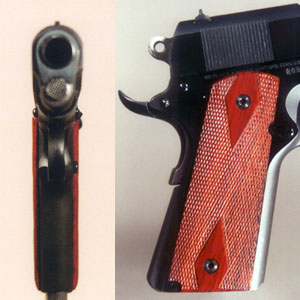
There were really three options for lightening the trigger: (1) replace the mainspring with a lighter one, (2) bend the sear spring, or (3) replace the sear spring. I didn’t want to bend the sear spring and I had a Chip McCormick sear spring handy. Visually comparing the McCormick sear spring against the Colt spring, it was immediately obvious that the McCormick spring was considerably lighter than the Colt spring. The McCormick sear spring seemed to be the path of least resistance so I switched it in.
Why am I allergic to bending the sear spring? This is one of the two places where you can make a 1911 dangerous. The other is the sear hook/hammer hook interface. Since I am not a Colt certified armorer and have never been taught the correct procedure for tuning a sear spring, I prefer to leave it alone if I can get by with it. An excessively light sear spring and/or improperly cut sear and hammer hooks can cause a gun to fire when you don’t want it to, burst fire, and even go full auto. These features may be cool on an M-16 when you’re expecting it, but they’re not cool on a .45 pistol when you aren’t expecting it.
The new sear spring gave about a pound reduction in the trigger pull, getting it back into the acceptable range, but it was still crunchy and a little loose in its tracks. The trigger itself is a short, M1911A1-style trigger and I have grown accustomed to the longer M1911-style trigger, so I replaced it with a McCormick skeletonized aluminum trigger. I stoned the edges of the trigger bow to make sure they were totally smooth and slathered it with Mil-Comm grease. This last mod rendered a smooth, non-wiggly 4 1/2 lb. trigger. The trigger could definitely be made lighter by tuning the sear spring, but there is such thing as too light a trigger. Mil-spec on the M1911A1 was a 5.5-6 lb. trigger pull, not 2.5 lb.
The finishing touch was a set of McCormick “Slim-Carry” rosewood grips. These grips are about 50% thinner than standard grips and require shorter stock bushings which come with the grips. These grips are a rich red and make an attractive contrast with the deep blue of the metal. The thinner grips feel good and further enhance the concealability of the slim M1911 frame.
Springs
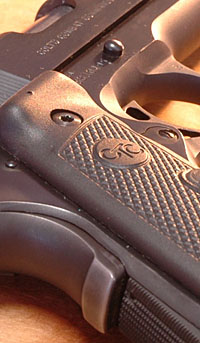
No refit of an M1911 would be complete without some attention to the springs. With the exception of the sear spring which came from McCormick, the spring set selected was from Wolff Gun Springs. For the mainspring (a.k.a. the hammer spring), a reduced power 21 lb. spring was selected. This weight was chosen to slightly reduce the sear-to-hammer-hook pressure which lightens the trigger pull perceptibly. Factory spec from Colt is 23 lbs. for the mainspring. It was replaced by a 21 lb. Wolff spring. This is not a big change, not big enough to affect ignition reliability, but just enough to lighten the trigger pull just a bit. Interestingly, factory spec from Kimber for the mainspring is 21 lbs. but Colt specifies 23 lbs.
For the recoil spring, I replaced the stock 18 lb. Colt spring with a 22 lb. Wolff spring. This is a choice based on reliability concerns. I have found that a stiffer recoil spring tends to reduce feed failures. I always shoot full power and +p loads. I would not use this heavy a spring for target or powder-puff loads, but I don’t shoot that kind of ammunition. A stronger recoil spring also reduces the battering of the slide against the frame when shooting hot loads.
For the firing pin spring, I installed the Wolff extra-power firing pin spring. While concerns about dropping an M1911 perfectly on its muzzle and causing an inertial discharge are mostly theoretical and approaching the level of myth, the true M1911 does not have a firing pin block and the additional insurance of the extra-power firing pin spring is probably not a bad thing.
To summarize the mods: Wilson beavertail and V-grip mainspring housing, McCormick sear spring, trigger and grips, and Wolff mainspring, recoil and firing pin springs. The result is a very comfortable and shootable gun that doesn’t eat up my hand, looks good and conceals well.
Ammo Testing
For match testing, I took the Commander to a Kentucky Defensive Pistol League match. It ran flawlessly with highly rewarding accuracy. Double taps were tight and I found the factory sights surprisingly easy to use. The mag release is too tight. I had to really punch it hard to get it to release. (I watched a hot dog with a $2000 race gun accidentally dump his mag during a stage by brushing his mag release, so maybe this isn’t too terrible, but I resolved to lighten it up a bit.)
I went out to Higginbotham’s for his shoot and to do some hollowpoint reliability testing. I tested Remington Gold Saber, Federal HydraShok, Fiocchi JHP, S&B hardball and the new Taurus all copper hollowpoints. The Remington, Hydrashok and Fiocchi ran fine. Jim pointed out that he has an original 1912-vintage M1911, completely unmodified, and HydraShoks run fine in it too. The Taurus loads were a different story. The first magazine ran OK, but on the second magazine, I got two feed failures. Accuracy on the Taurus stuff was also dismal. We shot the rest of it in a Springfield Mi-Spec as a sort of control and didn’t have any more problems with it. This ammo is not worth $24 for 20. I won’t buy any more. I got one feed failure on the S&B hardball when shooting from behind a barrel. Jim was watching and said he thought it was the way I was holding the gun rather than a gun problem. I didn’t have my arms extended and was holding the gun fairly close to my face and allowed it to “short stoke.”
Accuracy
Accuracy for the Combat Commander is about average. One can expect 2.5″ – 3″ groups at 25 yards. This pistol is set up for combat reliability, not match grade accuracy. With the hammer cocked and no magazine in the gun, you can make the slide rattle on the frame by shaking it side to side.
Conceptual Issues
One student of Colt’s offerings suggested that the Combat Commander is “the best pistol Colt ever built.” Others have suggested that the Commander configuration – full length grip with the 4″ or 4.25″ (true Commander) barrel length is the optimum setup for the 1911 platform. The legendary guru of the modern pistol method, Jeff Cooper, liked the Lightweight Commander but criticized the Combat Commander because he didn’t see that the 6 oz. increase in weight in the all-steel Combat Commander was justified. Another criticism lodged against the Commander configuration is that the shorter barrel length results in lower muzzle velocity in the .45 ACP cartridge. Different guns and loads return different test results, but generally, the loss of velocity in the .45 ACP cartridge comes out to somewhere between 50 and 70 feet per second per inch of barrel length, so that a cartridge that delivers 830 fps in a Government Model may give 780 fps in a Commander-length barrel, and remember, the 4.25″ measurement is breach to muzzle. Part of the 4.25″ is taken by the chamber so that the Commander only has about 3.5″ of real barrel. When using hollowpoints, the expansion threshold is fairly high, so muzzle velocity is an issue. Perhaps it’s less a concern in the .45 than in smaller rounds, but people still worry about it. For hardball 230 grain FMJ, there is really no significant difference in bullet performance between 780 and 830 fps. For those who want to insure reliable expansion of hollowpoints in the shorter barreled guns, 185 grain +p ammunition is recommended.
Returning to Col. Cooper’s criticism of the Combat Commander – that the weight increase over the 28 oz. Commander (a.k.a. the Lightweight Commander) is not justified – is there a good reason to take on the 6 oz. of extra weight in the Combat Commander? For that matter, in this day of highly successful polymer-framed guns with high capacity magazines, is there any justification for an all-steel 34 oz. pistol that tops off at 9 rounds? Well, as hard as it may be for the combat Tupperware set to understand, some people just don’t like plastic and aluminum alloy guns, especially for range and match shooting. This is a matter of personal taste and not altogether rational, but it’s a fact. When everything else is equal, heavier guns kick less than light guns. This can become an important factor for people who like to shoot high round count matches and training classes. Steel is easier to refinish than other materials and it is also quite durable, although the durability record of the Lightweight Commanders has been surprisingly good.
Heavier guns settle down on the target quicker for hammers, double taps, controlled pairs and other kinds of follow-up shots. IPSC Unlimited Class shooters find all sorts of ways to add weight to their guns, such as compensators, optics, full length dust covers, full length guide rods, and weighted magazine bases. Their collective experience in accurate speed shooting tells us something. Lightweight guns suffer from worse muzzle flip than do heavier guns.
As to round count, more is always better, but in the real world, a problem that can’t be solved with 9 rounds and a reload probably won’t be solved by 11 rounds and a reload either. Some have argued that the superior speed and accuracy of the 1911 more than compensates for the somewhat lower round count. Nevertheless, carry a spare magazine.
The Combat Commander is a beautifully balanced pistol. It rests in your hand well and points naturally. It lacks the muzzle-heavy feel of the Government Model and does not suffer from the muzzle flip of the shorter, super compact pistols. I find that I get on target quicker with the Commander-length gun than I do with Government Models, but the sight radius is still long enough to get good accuracy at longer distances. The full length grips of the Commander give you a better hold on the pistol than the shorter Officers’ sized grips. I’m one of those who find the Commander configuration to be the optimum 1911 for shooting. It feels good, looks good and shoots well. I doubt that the Combat Commander and clones will ever become wildly popular for concealed carry. At only .75” shorter than the Government Model, it’s still a fairly large and heavy gun by today’s standards. Yet, for looks, good shooting, and quality, it’s a contender for “the best gun Colt ever built.”
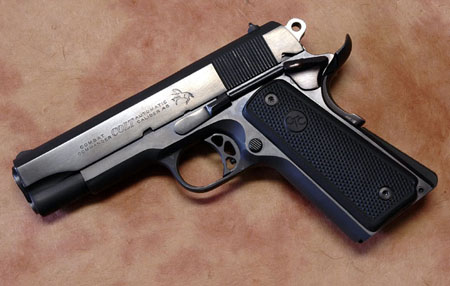

Comments, suggestions, contributions? Let me know